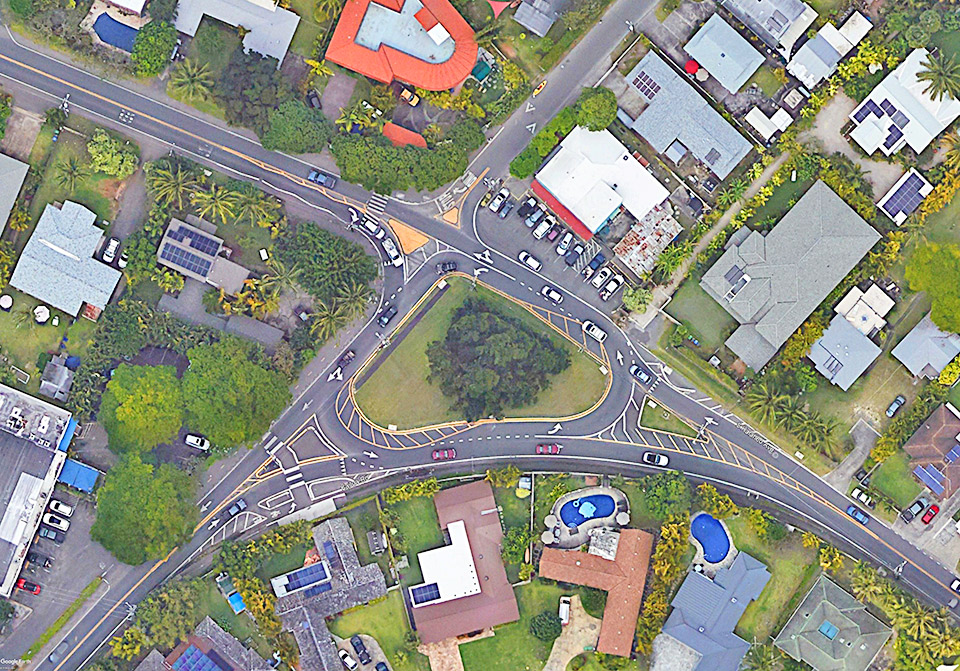Roundabouts on the Rise

Roundabout use has increased across Hawaii over the past decade as FHWA, ITE, and other professional organizations have included it in best practices and recent local county street design manuals all include a “roundabout first” policy when it comes to analyzing existing or new intersections.
In 2012, SSFM served as construction manager for the construction of a County of Maui single-lane roundabout at a primary intersection between a shopping center and high school in Kihei, Maui that included RRFBs at crosswalks to improve pedestrian safety and accessibility.
The County of Kauai won a $15.1 million federal TIGER Grant in 2015 following the design-build contracting with SSFM for complete street treatments along Hardy Street that included a single-lane roundabout to serve as a gateway treatment with enhanced multimodal travel outside of downtown Lihue.
The State of Hawaii installed its first single-lane roundabout in Pahoa on the island of Hawaii in 2016 to great success, however the State still holds concern regarding the use of multilane roundabouts due to their increased conflicts with multimodal users.
The City and County of Honolulu has recently expanded their toolbox using lighter/quicker/cheaper temporary treatments to test mini-circles and roundabouts in communities with conflicting demands.
SSFM completed the design of mini-circles along a transit route in Kaneohe that was constructed in 2019 with asphalt, markings, and signage as a part of a repaving project, thereby saving the C&C money. In addition, a high multimodal volume intersection at the entrance to Kailua Beach Park and the Lanikai community was reconfigured in 2018 to function as a roundabout, based on a design completed by SSFM, to test the ability for reduced vehicle delay and increased pedestrian/bicycle safety.
As Hawaii’s experience with roundabouts increases, a number of lessons learned enable further growth and improved use of different applications statewide. Needless to say, we are making progress.
Roundabouts on the Rise

Roundabout use has increased across Hawaii over the past decade as FHWA, ITE, and other professional organizations have included it in best practices and recent local county street design manuals all include a “roundabout first” policy when it comes to analyzing existing or new intersections.
In 2012, SSFM served as construction manager for the construction of a County of Maui single-lane roundabout at a primary intersection between a shopping center and high school in Kihei, Maui that included RRFBs at crosswalks to improve pedestrian safety and accessibility.
The County of Kauai won a $15.1 million federal TIGER Grant in 2015 following the design-build contracting with SSFM for complete street treatments along Hardy Street that included a single-lane roundabout to serve as a gateway treatment with enhanced multimodal travel outside of downtown Lihue.
The State of Hawaii installed its first single-lane roundabout in Pahoa on the island of Hawaii in 2016 to great success, however the State still holds concern regarding the use of multilane roundabouts due to their increased conflicts with multimodal users.
The City and County of Honolulu has recently expanded their toolbox using lighter/quicker/cheaper temporary treatments to test mini-circles and roundabouts in communities with conflicting demands.
SSFM completed the design of mini-circles along a transit route in Kaneohe that was constructed in 2019 with asphalt, markings, and signage as a part of a repaving project, thereby saving the C&C money. In addition, a high multimodal volume intersection at the entrance to Kailua Beach Park and the Lanikai community was reconfigured in 2018 to function as a roundabout, based on a design completed by SSFM, to test the ability for reduced vehicle delay and increased pedestrian/bicycle safety.
As Hawaii’s experience with roundabouts increases, a number of lessons learned enable further growth and improved use of different applications statewide. Needless to say, we are making progress.
Category:
Housing
